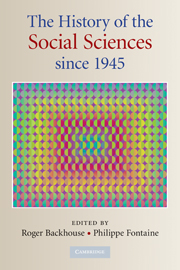8 - Toward a History of the Social Sciences
Published online by Cambridge University Press: 05 June 2012
Summary
We need to characterize American society of the mid-twentieth century in more psychological terms … for now the problems that concern us most border on the psychiatric.
C. Wright Mills (1951, p. 160).The Second World War and Its Aftermath
It is hard to overestimate the significance of the Second World War for the social sciences as a whole, even though its importance varied from one social science to another. The war and its aftermath brought about profound changes in Western societies, creating new problems that provided opportunities for social scientists to demonstrate their expertise. In the postwar decades, notably the 1960s, as a result of their efforts to tackle urgent social problems, the traditional domains of the social sciences were redefined. Of course many of the conceptual frameworks or paradigms within which social scientists operated had roots that went much further back, but the changed context brought about profound transformations. The most obvious change concerned the political position of the United States in relation to Europe: to quote British historian Tony Judt (2007, p. 13), “Europe in the aftermath of the Second World War offered a prospect of utter misery and desolation. … Europeans felt hopeless, they were exhausted – and for good reason.” The physical destruction had been immense, the death toll, especially among civilians, vastly higher than that in the First World War, and at the end of the war tens of millions of people were displaced, in part as a result of “an unprecedented exercise in ethnic cleansing and population transfer” (p.24): Europe was in chaos and the split between East and West was accentuated.
- Type
- Chapter
- Information
- The History of the Social Sciences since 1945 , pp. 184 - 234Publisher: Cambridge University PressPrint publication year: 2010
References
- 11
- Cited by



